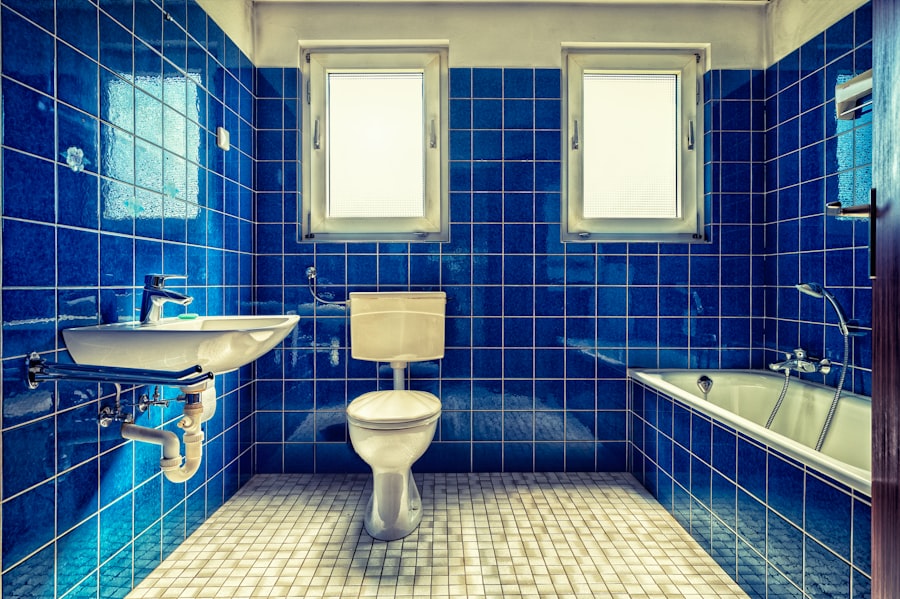A bathroom replacement can significantly enhance the overall value of a home, making it an attractive investment for homeowners. One of the most compelling benefits is the potential increase in property value. Real estate experts often cite updated bathrooms as a key selling point, with buyers willing to pay a premium for modern, functional spaces.
An outdated bathroom can detract from a home’s appeal, while a newly renovated one can create a lasting impression, making it easier to sell in a competitive market. Furthermore, a bathroom replacement can also improve the overall aesthetic of a home, transforming a mundane space into a stylish retreat that reflects personal taste and contemporary design trends. Beyond financial considerations, the practical advantages of a bathroom replacement are equally significant.
Older bathrooms often suffer from issues such as leaks, mold, and outdated plumbing fixtures that can lead to costly repairs down the line. By replacing an old bathroom, homeowners can address these problems proactively, ensuring that their new space is not only visually appealing but also functional and safe. Modern plumbing systems are designed to be more efficient and reliable, reducing the likelihood of future issues.
Additionally, a well-planned bathroom replacement can enhance daily routines, providing a more enjoyable and efficient experience for all family members.
Key Takeaways
- Bathroom replacement enhances home value and personal comfort.
- Thoughtful design and layout choices optimize space and usability.
- Selecting durable, high-quality materials ensures long-lasting results.
- Understanding installation helps manage timelines and expectations.
- Incorporating energy-efficient and luxury features boosts functionality and comfort.
Choosing the Right Design and Layout
Selecting the right design and layout for a bathroom is crucial to maximizing both aesthetics and functionality. The first step in this process is to assess the existing space and determine how it can be optimized. For instance, if the current layout feels cramped or inefficient, it may be worth considering a reconfiguration that allows for better flow and accessibility.
Popular layouts include the classic three-quarter bath, which features a shower, toilet, and sink, or a full bath with a tub included. Each layout has its own advantages depending on the needs of the household and the available space. In addition to layout considerations, the design elements play a pivotal role in creating a cohesive look.
Homeowners should consider their personal style when selecting colors, fixtures, and finishes. For example, a minimalist design may favor clean lines and neutral colors, while a more eclectic approach might incorporate bold patterns and vibrant hues. It’s also essential to think about how the design will complement the rest of the home.
A bathroom that harmonizes with adjacent rooms can create a seamless transition throughout the living space. Utilizing design software or consulting with an interior designer can help visualize different options and ensure that the final design aligns with both functionality and aesthetic preferences.
Selecting the Best Materials for Your Bathroom

The choice of materials in a bathroom replacement is critical not only for visual appeal but also for durability and maintenance. Bathrooms are unique environments that experience high humidity levels, making it essential to select materials that can withstand moisture without deteriorating over time. For instance, ceramic tiles are a popular choice for flooring and walls due to their water resistance and ease of cleaning.
Additionally, natural stone options like granite or marble can add an element of luxury while providing durability when properly sealed. Countertops are another area where material selection is vital. Quartz has gained popularity in recent years due to its non-porous nature, which makes it resistant to stains and bacteria.
On the other hand, solid surface materials offer seamless designs that can be molded into various shapes, providing both functionality and aesthetic appeal. When selecting fixtures such as faucets and showerheads, homeowners should consider materials like brass or stainless steel for their longevity and resistance to corrosion. Ultimately, choosing high-quality materials will not only enhance the bathroom’s appearance but also contribute to its longevity and ease of maintenance.
Understanding the Installation Process
| Step | Description | Estimated Time | Required Tools | Common Issues |
|---|---|---|---|---|
| 1. Preparation | Gather all necessary materials and review installation instructions. | 10 minutes | Instruction manual, checklist | Missing components, unclear instructions |
| 2. Site Inspection | Check the installation site for compatibility and safety. | 15 minutes | Measuring tape, level | Uneven surfaces, insufficient space |
| 3. Component Assembly | Assemble parts as per the guidelines before installation. | 30 minutes | Screwdriver, wrench, assembly tools | Incorrect assembly, missing screws |
| 4. Installation | Install the assembled components at the designated site. | 45 minutes | Drill, screws, anchors | Misalignment, loose fittings |
| 5. Testing & Calibration | Test the installation for proper operation and make adjustments. | 20 minutes | Testing equipment, calibration tools | Malfunction, inaccurate calibration |
| 6. Final Inspection | Conduct a thorough inspection to ensure quality and safety. | 10 minutes | Inspection checklist | Overlooked defects, safety hazards |
The installation process for a bathroom replacement can be complex and requires careful planning to ensure everything goes smoothly. Initially, homeowners should prepare by creating a detailed timeline that outlines each phase of the project. This includes demolition of existing fixtures, plumbing adjustments, electrical work, installation of new materials, and final touches such as painting or decorating.
Engaging professionals who specialize in bathroom renovations can streamline this process significantly; their expertise ensures that all work complies with local building codes and regulations. During the installation phase, it’s essential to maintain open communication with contractors to address any unexpected challenges that may arise. For example, hidden plumbing issues or structural concerns may become apparent once demolition begins.
Being prepared for such contingencies can help mitigate delays and additional costs. Homeowners should also consider how long they will be without access to their bathroom during renovations; planning for alternative arrangements can alleviate stress during this period. By understanding the installation process thoroughly, homeowners can better navigate their renovation journey with confidence.
Maximizing Space and Functionality
Maximizing space in a bathroom is particularly important in smaller homes where every square foot counts. Clever design strategies can transform even the most compact bathrooms into functional havens. One effective approach is to utilize vertical space by installing shelves or cabinets that reach up to the ceiling.
This not only provides additional storage but also draws the eye upward, creating an illusion of height in the room. Floating vanities are another popular trend that frees up floor space while offering storage solutions without overwhelming the area. Incorporating multifunctional fixtures can also enhance usability in smaller bathrooms.
For instance, vanities with built-in storage or mirrors with integrated lighting serve dual purposes while maintaining a sleek appearance. Additionally, pocket doors or bi-fold doors can save valuable space compared to traditional swinging doors. Thoughtful placement of lighting fixtures can further enhance functionality; layered lighting—combining ambient, task, and accent lighting—can create a well-lit environment that caters to various activities from grooming to relaxation.
Incorporating Energy-Efficient Features

In today’s environmentally conscious world, incorporating energy-efficient features into a bathroom replacement is not only beneficial for the planet but also for homeowners’ wallets. Water-saving fixtures such as low-flow toilets and faucets significantly reduce water consumption without sacrificing performance. For example, modern low-flow toilets use as little as 1.28 gallons per flush compared to older models that may use up to 3.5 gallons or more.
This reduction in water usage translates into lower utility bills over time. Energy-efficient lighting is another critical component of a sustainable bathroom design. LED bulbs consume significantly less energy than traditional incandescent bulbs and have a longer lifespan, making them an economical choice in the long run.
Additionally, installing motion sensors or dimmer switches can further enhance energy savings by ensuring lights are only used when needed. Homeowners may also consider incorporating natural light through strategically placed windows or skylights; this not only reduces reliance on artificial lighting but also creates a more inviting atmosphere within the space.
Adding Luxury and Comfort with Modern Amenities
The modern bathroom has evolved into more than just a functional space; it has become a sanctuary for relaxation and self-care. Adding luxury amenities can elevate the overall experience of using the bathroom significantly. Features such as heated floors provide comfort during colder months while enhancing the overall ambiance of the room.
Similarly, installing a rainfall showerhead or a soaking tub can transform daily routines into spa-like experiences that promote relaxation. Smart technology is another avenue through which homeowners can infuse luxury into their bathrooms. Smart mirrors equipped with LED lighting and touch controls allow users to adjust brightness levels or even display weather updates while getting ready in the morning.
Additionally, smart toilets with features like heated seats, bidet functions, and automatic flushing offer unparalleled convenience and hygiene. Integrating these modern amenities not only enhances comfort but also adds an element of sophistication that reflects contemporary living standards.
Maintaining Your New Bathroom for Longevity
Once the bathroom replacement is complete, maintaining its beauty and functionality is essential for ensuring longevity. Regular cleaning is crucial in preventing mold growth and keeping surfaces looking pristine; using non-abrasive cleaners specifically designed for bathroom surfaces will help preserve finishes without causing damage. Homeowners should also pay attention to caulking around sinks, tubs, and showers; replacing worn or cracked caulk prevents water damage and maintains a clean appearance.
In addition to routine cleaning, periodic inspections of plumbing fixtures are necessary to catch any potential issues early on. Checking for leaks under sinks or around toilets can prevent water damage that may lead to costly repairs down the line. Furthermore, ensuring proper ventilation in the bathroom helps control humidity levels; using exhaust fans during showers can significantly reduce moisture buildup that contributes to mold growth.
By adopting these maintenance practices, homeowners can enjoy their newly renovated bathrooms for years to come while preserving their investment’s value and appeal.




